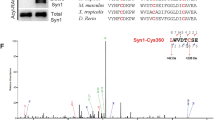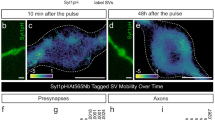Abstract
Different types of cargo vesicles containing presynaptic proteins are transported from the nerve cell body to the nerve terminal, and participate in the formation of active zones. However, the identity of the membranous cargoes and the nature of the motor–cargo interactions remain unsolved. Here, we report the identification of a syntaxin-1-binding protein named syntabulin. Syntabulin attaches syntaxin-containing vesicles to microtubules and migrates with syntaxin within the processes of hippocampal neurons. Knock-down of syntabulin expression with targeted small interfering RNAs (siRNAs) or interference with the syntabulin–syntaxin interaction inhibit attachment of syntaxin-cargo vesicles to microtubules and reduce syntaxin-1 distribution in neuronal processes. Furthermore, conventional kinesin I heavy chain binds to syntabulin and associates with syntabulin-linked syntaxin vesicles in vivo. These findings suggest that syntabulin functions as a linker molecule that attaches syntaxin-cargo vesicles to kinesin I, enabling the transport of syntaxin-1 to neuronal processes.
This is a preview of subscription content, access via your institution
Access options
Subscribe to this journal
Receive 12 print issues and online access
$209.00 per year
only $17.42 per issue
Buy this article
- Purchase on Springer Link
- Instant access to full article PDF
Prices may be subject to local taxes which are calculated during checkout








Similar content being viewed by others
References
Rothman, J.E. Mechanisms of intracellular protein transport. Nature 372, 55–63 (1994).
Bajjalieh, S.M. & Scheller, R.^H. The biochemistry of neurotransmitter secretion. J. Biol. Chem. 270, 1971–1974 (1995).
Südhof, T.C. The synaptic vesicle cycle: a cascade of protein-protein interactions. Nature 375, 645–653 (1995).
Hilfiker, S., Greengard, P. & Augustine, G.J. Coupling calcium to SNARE-mediated synaptic vesicle fusion. Nature Neurosci. 2, 104–106 (1999).
Trimble, W.S., Cowan, D.M. & Scheller, R.H. VAMP-1: a synaptic vesicle-associated integral membrane protein. Proc. Natl Acad. Sci. 85, 4538–4542 (1988).
Bennett, M.K., Calakos, N. & Scheller, R.H. Syntaxin: a synaptic protein implicated in docking of synaptic vesicles at presynaptic active zones. Science 257, 255–259 (1992).
Yoshida, A., Oho, C., Omori, A., Kuwahara, R., Ito, T. & Takahashi, M. HPC-1 is associated with synaptotagmin and W-conotoxin receptor. J. Biol. Chem. 267, 24925–24928 (1992).
Oyler, G.A. et al. The identification of a novel synaptosomal-associated protein, SNAP-25, differentially expressed by neuronal subpopulations. J. Cell Biol. 109, 3039–3052 (1989).
Söllner, T. et al. SNAP receptors implicated in vesicle targeting and fusion. Nature 362, 318–324 (1993).
Calakos, N., Bennett, M.K., Peterson, K. & Scheller, R.H. Protein-protein interactions contributing to the specificity of intracellular vesicular trafficking. Science 263, 1146–1149 (1994).
Fasshauer, D., Eliason, W.K., Brünger, A.T. & Jahn, R. Identification of a minimal core of the synaptic SNARE complex sufficient for reversible assembly and disassembly. Biochemistry 37, 10354–10362 (1998).
Hirokawa, N. Kinesin and dynein superfamily proteins and the mechanism of organelle transport. Science 279, 519–526 (1998).
Bradke, F. & Dotti, C.G. Membrane traffic in polarized neurons. Biochem. Biophys. Acta. 1404, 245–258 (1998).
Goldstein, L.S. & Philp, A.V. The road less travelled: emerging principles of kinesin motor utilization. Annu. Rev. Cell Dev. Biol. 15, 141–183 (1999).
Zhai, R.G. et al. Assembling the presynaptic active zone: a characterization of an active one precursor vesicle. Neuron 29, 131–143 (2001).
Shapira, M. et al. Unitary assembly of presynaptic active zones from Piccolo-Bassoon transport vesicles. Neuron 38, 237–252 (2003).
Sampo, B., Kaech, S., Kunz, S. & Banker, G. Two distinct mechanisms target membrane proteins to the axonal surface. Neuron 37, 611–24 (2003).
Kraszewski, K. et al. Synaptic vesicle dynamics in living cultured hippocampal neurons visualized with CY3-conjugated antibodies directed against the lumenal domain of synaptotagmin. J. Neurosci. 15, 4328–4342 (1995).
Nakata, T., Terada, S. & Hirokawa, N. Visualization of the dynamics of synaptic vesicle and plasma membrane proteins in living axons. J. Cell Biol. 140, 659–674 (1998).
Ahmari, S.E., Buchanan, J. & Smith, S.J. Assembly of presynaptic active zones from cytoplasmic transport packets. Nature Neurosci. 3, 445–451 (2000).
Roos, J. & Kelly, R.B. Preassembly and transport of nerve terminals: a new concept of axonal transport. Nature Neurosci. 3, 415–417 (2000).
Almenar-Queralt, A. & Goldstein, L.S. Linkers, packages and pathways: new concepts in axonal transport. Curr. Opin. Neurobiol. 11, 550–557 (2001).
Schroer, T.A. Motors, clutches and brakes for membrane traffic: a commemorative review in honor of Thomas Kreis. Traffic 1, 3–10 (2000).
Manning, B.D. & Snyder, M. Drivers and passengers wanted! The role of kinesin-associated proteins. Trends. Cell Biol. 10, 281–289 (2000).
Goldstein, L.S. & Yang, Z. Microtubule-based transport systems in neurons: the roles of kinesins and dyneins. Annu. Rev. Neurosci. 23, 39–71 (2000).
Kamal, A., Stokin, G.B., Yang, Z., Xia, C.H. & Goldstein, L.S. Axonal transport of amyloid precursor protein is mediated by direct binding to the kinesin light chain subunit of kinesin-I. Neuron 28, 449–459 (2000).
Bowman, A.B. et al. Kinesin-dependent axonal transport is mediated by the sunday driver (SYD) protein. Cell 103, 583–594 (2000).
Nakagawa, T. et al. A novel motor, KIF13A, transports mannose-6-phosphate receptor to plasma membrane through direct interaction with AP-1 complex. Cell 103, 569–581 (2000).
Takeda, S. et al. Kinesin superfamily protein 3 (KIF3) motor transports fodrin-associating vesicles important for neurite building. J. Cell Biol. 148, 1255–1265 (2000).
Setou, M., Nakagawa, T., Seog, D.H. & Hirokawa, N. Kinesin superfamily motor protein KIF17 and mLin-10 in NMDA receptor-containing vesicle transport. Science 288, 1796–1802 (2000).
Kamal, A. & Goldstein, L.S. Principles of cargo attachment to cytoplasmic motor proteins. Curr. Opin. Cell Biol. 14, 63–68 (2002).
Lao, G. et al. Syntaphilin: a syntaxin-1 clamp that controls SNARE assembly. Neuron 25, 191–201 (2000).
Das, S., Gerwin, C. & Sheng, Z.-H. Syntaphilin binds to dynamin-1 and inhibits dynamin-dependent endocytosis. J. Biol. Chem. 278, 41221–41226 (2003).
Muresan, V. et al. Dynactin-dependent, dynein-driven vesicle transport in the absence of membrane proteins: a role for spectrin and acidic phospholipids. Mol. Cell. 7, 173–183 (2001).
Safieddine, S. et al. Ocsyn, a novel syntaxin-interacting protein enriched in the subapical region of inner hair cells. Mol. Cell. Neurosci. 20, 343–353 (2002).
Garcia, E.P., McPherson, P.S., Chilcote, T.J., Takei, K. & De Camilli, P. rbSec1A and B colocalize with syntaxin 1 and SNAP-25 throughout the axon, but are not in a stable complex with syntaxin. J. Cell Biol. 129, 105–20 (1995).
Diefenbach, R.J., Mackay, J.P., Armati, P.J. & Cunnimgham, A.L. The C-terminal region of the Stalk domain of ubiquitous human kinesin heavy chain contains the binding site for kinesin light chain. Biochemistry 37, 16663–16670 (1998).
Gunawardena, S. and Goldstein, L.S. Cargo-carrying motor vehicles on the neuronal highway: transport pathways and neurodegenerative disease. J. Neurobiol. 58, 258–271 (2004).
Burack, M.A., Silverman, M.A. & Banker, G. The role of selective transport in neuronal protein sorting. Neuron 26, 465–472 (2000).
Sheetz, M.P., Pfister, K.K., Bulinski, J.C. & Cotman, C.W. Mechanisms of trafficking in axons and dendrites: implications for development and neurodegeneration. Prog. Neurobiol. 55, 577–594 (1998).
Vale, R.D. The molecular motor toolbox for intracellular transport. Cell 112, 467–480 (2003).
Horton, A.C. and Ehlers, M.D. Neuronal polarity and trafficking. Neuron 40, 277–295 (2003).
Donaldson, J.G. and Lippincott-Schwartz, J. Sorting and Signaling at the Golgi complex. Cell 101, 693–696 (2000).
Allan, V.J., Thompson, H.M. & McNiven, M.A. Motoring around the Golgi. Nature Cell Biol. 4, 236–242 (2002).
Dell, K.R. Dynactin polices two-way organelle traffic. J. Cell Biol. 160, 291–293 (2003).
Verhey, K.J. et al. Cargo of kinesin identified as JIP scaffolding proteins and associated signaling molecules. J. Cell Biol. 152, 959–970 (2001).
Lupas, A., Van Dyke, M. & Stock, J. Predicting coiled coils from protein sequences. Science 252, 1162–1164 (1991).
Goslin, K., Asmussen, H. & Banker, G. in Culturing Nerve Cells 2nd edn (eds Banker, G. and Goslin, K.) 339–370 (M.I.T. Press, Cambridge, USA, 1998).
Acknowledgements
We thank the following people for their help: K. J. Swartz, C. Blackstone and C. T. Yokoyama for their critical reading of the manuscript; P. De Camilli, J. Lippincott-Schwartz and members of the Sheng laboratory for discussion; L. S. Goldstein for GST–KLC constructs and R. J. Diefenbach for His–KHC DNAs; M. Takahashi for SNARE antibodies; J. W. Nagle for DNA sequencing; S. Cheng for her assistance in EM examination; and J. Kang for image analysis. This work was supported by intramural research program of NINDS, NIH (Z.-H.S.). Q.C. is a graduate student of the NIH-SSMU (Shanghai Second Medical University) Joint Ph.D. Program in Neuroscience partially supported by the Shanghai Science Technology Development Foundation (01JC4023). We acknowledge P.-H. Lu for her support to the joint NIH-SSMU training program.
Author information
Authors and Affiliations
Corresponding author
Ethics declarations
Competing interests
The authors declare no competing financial interests.
Supplementary information
Supplementary Figures
Figure S1, S2, S3 and S4 (PDF 574 kb)
Legends accompanying movies
Rights and permissions
About this article
Cite this article
Su, Q., Cai, Q., Gerwin, C. et al. Syntabulin is a microtubule-associated protein implicated in syntaxin transport in neurons. Nat Cell Biol 6, 941–953 (2004). https://doi.org/10.1038/ncb1169
Received:
Accepted:
Published:
Issue Date:
DOI: https://doi.org/10.1038/ncb1169
This article is cited by
-
Syntabulin regulates neuronal excitation/inhibition balance and epileptic seizures by transporting syntaxin 1B
Cell Death Discovery (2023)
-
Defects in syntabulin-mediated synaptic cargo transport associate with autism-like synaptic dysfunction and social behavioral traits
Molecular Psychiatry (2021)
-
Vertebrate Presynaptic Active Zone Assembly: a Role Accomplished by Diverse Molecular and Cellular Mechanisms
Molecular Neurobiology (2018)
-
Microtubule Motor Proteins and the Mechanisms of Synaptic Plasticity
Neuroscience and Behavioral Physiology (2017)
-
Syntabulin regulates the trafficking of PICK1-containing vesicles in neurons
Scientific Reports (2016)



